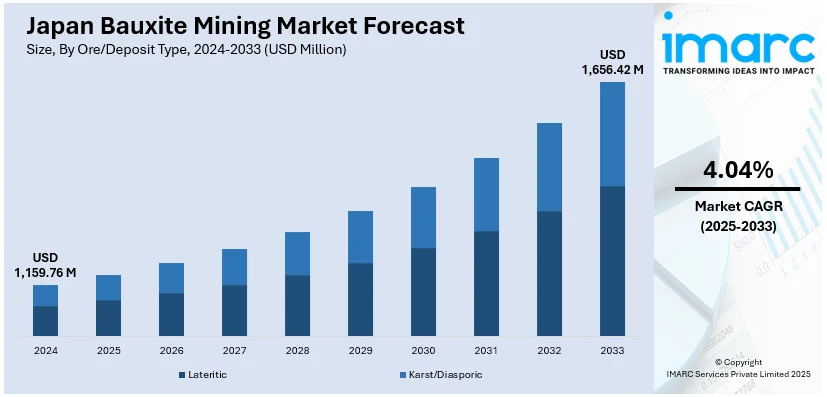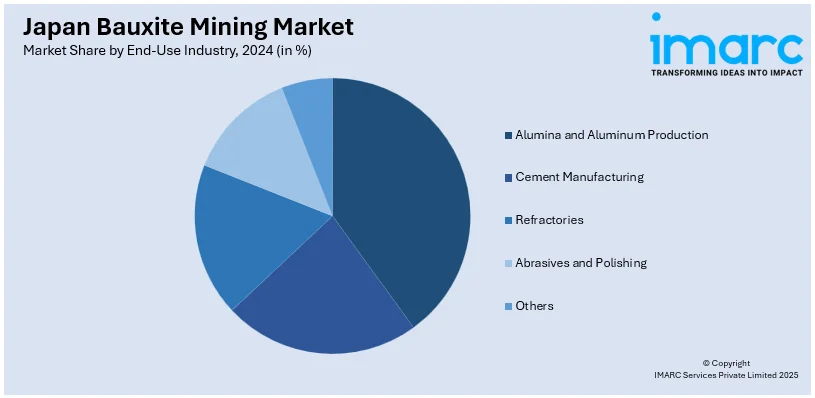
Japan Bauxite Mining Market Size, Share, Trends and Forecast by Ore/Deposit Type, Grade, Processing Stage, End-Use Industry, and Region, 2025-2033
Japan Bauxite Mining Market Overview:
The Japan bauxite mining market size reached USD 1,159.76 Million in 2024. Looking forward, IMARC Group expects the market to reach USD 1,656.42 Million by 2033, exhibiting a growth rate (CAGR) of 4.04% during 2025-2033. Growing demand from aluminum smelting, rising infrastructure and construction projects, growth in automotive and packaging industries, and efforts to secure raw material supply chains are some of the factors contributing to Japan bauxite mining market share. Government initiatives promoting resource security and import dependency reduction further support industry growth.
|
Report Attribute
|
Key Statistics
|
|---|---|
|
Base Year
|
2024
|
|
Forecast Years
|
2025-2033
|
|
Historical Years
|
2019-2024
|
| Market Size in 2024 | USD 1,159.76 Million |
| Market Forecast in 2033 | USD 1,656.42 Million |
| Market Growth Rate 2025-2033 | 4.04% |
Japan Bauxite Mining Market Trends:
Rising Focus on Alternative Supply Chains
Japan has been actively securing diversified sources of bauxite to safeguard its aluminum sector. With limited domestic reserves, the country depends on imports, mainly from Australia, Indonesia, and Guinea. Recent years have shown a shift in strategy, as Japanese trading houses and aluminum producers invest in long-term agreements and overseas joint ventures to secure reliable supply. This is partly a response to geopolitical tensions and export restrictions that previously disrupted flows from Southeast Asia. Beyond contracts, Japan is also investing in logistics infrastructure, such as deep-sea ports and bulk carrier fleets, to reduce import risks. The emphasis on building resilient supply chains reflects not just commercial caution but also national policy, as aluminum remains critical for automotive, packaging, and electronics manufacturing. As Japan moves toward more energy-efficient and lightweight production, stable access to raw bauxite is treated as an essential safeguard for industrial competitiveness. These factors are intensifying the Japan bauxite mining market growth.

To get more information on this market, Request Sample
Environmental and Recycling Push Reducing Bauxite Dependence
A very different trend shaping the Japanese bauxite market is the country’s aggressive pursuit of recycling and secondary aluminum production. Japan is among the global leaders in aluminum scrap collection, with a well-developed system for recovering used cans, construction material, and automotive components. This has reduced the pressure on raw bauxite imports while aligning with Japan’s carbon reduction goals. The government and industry associations promote closed-loop recycling, which requires only a fraction of the energy compared to primary aluminum smelting. Advanced sorting technologies and high recovery rates are allowing domestic smelters to substitute a greater share of imports with scrap-based feedstock. As sustainability targets become more stringent, companies in Japan are integrating recycled aluminum into their long-term procurement strategies. This trend not only supports emissions goals but also shields industries from volatile global bauxite prices. Over time, recycling may reshape demand patterns, making Japan less vulnerable to external supply disruptions and more self-reliant in aluminum production.
Japan Bauxite Mining Market Segmentation:
IMARC Group provides an analysis of the key trends in each segment of the market, along with forecasts at the country and regional levels for 2025-2033. Our report has categorized the market based on ore/deposit type, grade, processing stage, and end-use industry.
Ore/Deposit Type Insights:
- Lateritic
- Gibbsite
- Boehmite
- Karst/Diasporic
The report has provided a detailed breakup and analysis of the market based on the ore/deposit type. This includes lateritic (gibbsite and boehmite) and karst/diasporic.
Grade Insights:
- Metallurgical-grade
- Refractory-grade
- Abrasive-grade
- Cement-grade
- Chemical-grade
The report has provided a detailed breakup and analysis of the market based on the grade. This includes metallurgical-grade, refractory-grade, abrasive-grade, cement-grade, and chemical-grade.
Processing Stage Insights:
- Direct Shipping Ore (DSO)
- Beneficiated
- Calcined Bauxite
The report has provided a detailed breakup and analysis of the market based on the processing stage. This includes direct shipping ore (DSO), beneficiated, and calcined bauxite.
End-Use Industry Insights:

- Alumina and Aluminum Production
- Cement Manufacturing
- Refractories
- Abrasives and Polishing
- Others
A detailed breakup and analysis of the market based on the end-use industry have also been provided in the report. This includes alumina and aluminum production, cement manufacturing, refractories, abrasives and polishing, and others.
Regional Insights:
- Kanto Region
- Kansai/Kinki Region
- Central/Chubu Region
- Kyushu-Okinawa Region
- Tohoku Region
- Chugoku Region
- Hokkaido Region
- Shikoku Region
The report has also provided a comprehensive analysis of all the major regional markets, which include Kanto Region, Kansai/Kinki Region, Central/Chubu Region, Kyushu-Okinawa Region, Tohoku Region, Chugoku Region, Hokkaido Region, and Shikoku Region.
Competitive Landscape:
The market research report has also provided a comprehensive analysis of the competitive landscape. Competitive analysis such as market structure, key player positioning, top winning strategies, competitive dashboard, and company evaluation quadrant has been covered in the report. Also, detailed profiles of all major companies have been provided.
Japan Bauxite Mining Market News:
- In August 2025, Sojitz Corporation and JOGMEC partnered with Alcoa’s Australian subsidiary through Japan Australia Gallium Associates to study gallium recovery from bauxite-derived alumina refineries in Western Australia. As gallium is sourced from trace amounts in bauxite, the project highlights Japan’s strategy to secure critical minerals linked to its aluminum supply chain. Production could begin in 2026, supporting Japan’s demand for semiconductors, LEDs, and renewable energy technologies.
Japan Bauxite Mining Market Report Coverage:
| Report Features | Details |
|---|---|
| Base Year of the Analysis | 2024 |
| Historical Period | 2019-2024 |
| Forecast Period | 2025-2033 |
| Units | Million USD |
| Scope of the Report |
Exploration of Historical Trends and Market Outlook, Industry Catalysts and Challenges, Segment-Wise Historical and Future Market Assessment:
|
| Ore/Deposit Types Covered |
|
| Grades Covered | Metallurgical-grade, Refractory-grade, Abrasive-grade, Cement-grade, Chemical-grade |
| Processing Stages Covered | Direct Shipping Ore (DSO), Beneficiated, Calcined Bauxite |
| End-Use Industries Covered | Alumina and Aluminum Production, Cement Manufacturing, Refractories, Abrasives and Polishing, Others |
| Regions Covered | Kanto Region, Kansai/Kinki Region, Central/Chubu Region, Kyushu-Okinawa Region, Tohoku Region, Chugoku Region, Hokkaido Region, Shikoku Region |
| Customization Scope | 10% Free Customization |
| Post-Sale Analyst Support | 10-12 Weeks |
| Delivery Format | PDF and Excel through Email (We can also provide the editable version of the report in PPT/Word format on special request) |
Key Questions Answered in This Report:
- How has the Japan bauxite mining market performed so far and how will it perform in the coming years?
- What is the breakup of the Japan bauxite mining market on the basis of ore/deposit type?
- What is the breakup of the Japan bauxite mining market on the basis of grade?
- What is the breakup of the Japan bauxite mining market on the basis of processing stage?
- What is the breakup of the Japan bauxite mining market on the basis of end-use industry?
- What is the breakup of the Japan bauxite mining market on the basis of region?
- What are the various stages in the value chain of the Japan bauxite mining market?
- What are the key driving factors and challenges in the Japan bauxite mining market?
- What is the structure of the Japan bauxite mining market and who are the key players?
- What is the degree of competition in the Japan bauxite mining market?
Key Benefits for Stakeholders:
- IMARC’s industry report offers a comprehensive quantitative analysis of various market segments, historical and current market trends, market forecasts, and dynamics of the Japan bauxite mining market from 2019-2033.
- The research report provides the latest information on the market drivers, challenges, and opportunities in the Japan bauxite mining market.
- Porter's five forces analysis assist stakeholders in assessing the impact of new entrants, competitive rivalry, supplier power, buyer power, and the threat of substitution. It helps stakeholders to analyze the level of competition within the Japan bauxite mining industry and its attractiveness.
- Competitive landscape allows stakeholders to understand their competitive environment and provides an insight into the current positions of key players in the market.
Need more help?
- Speak to our experienced analysts for insights on the current market scenarios.
- Include additional segments and countries to customize the report as per your requirement.
- Gain an unparalleled competitive advantage in your domain by understanding how to utilize the report and positively impacting your operations and revenue.
- For further assistance, please connect with our analysts.
 Request Customization
Request Customization
 Speak to an Analyst
Speak to an Analyst
 Request Brochure
Request Brochure
 Inquire Before Buying
Inquire Before Buying




.webp)




.webp)












